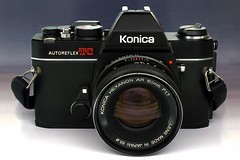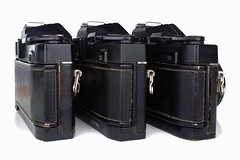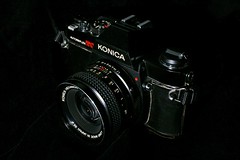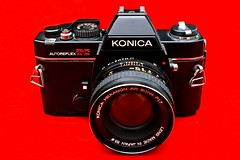Difference between revisions of "Konica Autoreflex TC"
(fixed redirect concern and reverted back to 135) |
(added internal link and typos) |
||
| Line 31: | Line 31: | ||
}} | }} | ||
| − | The '''Konica Autoreflex TC''' was introduced in 1976 and manufactured until 1982. In Japan, it was sold as the '''Acom-1'''. It was designed as an entry-level model with limited features and was sold at a competitive price. Today, these cameras can be a real bargain as so many were sold in | + | The '''[[Konica]] Autoreflex TC''' was introduced in 1976 and manufactured until 1982. In Japan, it was sold as the '''Acom-1'''. It was designed as an entry-level model with limited features and was sold at a competitive price. Today, these cameras can be a real bargain as so many were sold in its initial release. |
== Construction == | == Construction == | ||
The Autoreflex TC was smaller and lighter than any previous Konica slr. It achieved this distinction because the body used plastic parts for bringing down the weight and lowering the cost of construction, but the frame was still made of metal. The top cover with the prism housing was cast as one piece of plastic but was very resistant to wear. There was no standard silver and black version like most cameras of the era, the Autoreflex TC was offered only in black. | The Autoreflex TC was smaller and lighter than any previous Konica slr. It achieved this distinction because the body used plastic parts for bringing down the weight and lowering the cost of construction, but the frame was still made of metal. The top cover with the prism housing was cast as one piece of plastic but was very resistant to wear. There was no standard silver and black version like most cameras of the era, the Autoreflex TC was offered only in black. | ||
| − | It featured an improved, brighter viewfinder and was equipped with split-image focusing and a microprism ring. A new version of Konica's Hexanon AR 50mm F/1.7 lens was developed specifically for the Autoreflex TC. | + | It featured an improved, brighter viewfinder and was equipped with split-image focusing and a microprism ring. A new version of [[Konica]]'s [[Hexanon]] AR 50mm F/1.7 lens was developed specifically for the Autoreflex TC. Its design and optics have garnered accolades and it has become known as one of the best 50mm lenses of the era. |
== Versions == | == Versions == | ||
| − | There were several version of the Autoreflex TC. The first version featured the Konica logo in all upper-case letters, a metal back lock and different film guides than later models. An early change turned the metal back lock into a plastic part. Later, when the Konica logo changed to lower case letters except for the intial capital, the metal base plate, with the serial number stamped on the bottom, became a plastic piece with the serial number molded into the back and highlighted with white paint. | + | There were several version of the Autoreflex TC. The first version featured the [[Konica]] logo in all upper-case letters, a metal back lock and different film guides than later models. An early change turned the metal back lock into a plastic part. Later, when the Konica logo changed to lower case letters except for the intial capital, the metal base plate, with the serial number stamped on the bottom, became a plastic piece with the serial number molded into the back and highlighted with white paint. |
{{Flickr_image | {{Flickr_image | ||
| − | |image_source= http://www.flickr.com/photos/49656291@N00/3752051502/in/ | + | |image_source= http://www.flickr.com/photos/49656291@N00/3752051502/in/pool-camerawiki/ |
|image= http://farm3.static.flickr.com/2518/3752051502_79c492e569_m.jpg | |image= http://farm3.static.flickr.com/2518/3752051502_79c492e569_m.jpg | ||
|image_align= left | |image_align= left | ||
| Line 50: | Line 50: | ||
== Gallery Images == | == Gallery Images == | ||
{{Flickr_image | {{Flickr_image | ||
| − | |image_source= http://www.flickr.com/photos/49656291@N00/4340380293/in/ | + | |image_source= http://www.flickr.com/photos/49656291@N00/4340380293/in/pool-camerawiki/ |
|image= http://farm3.static.flickr.com/2690/4340380293_ba8a35660f_m.jpg | |image= http://farm3.static.flickr.com/2690/4340380293_ba8a35660f_m.jpg | ||
|image_align= left | |image_align= left | ||
| Line 56: | Line 56: | ||
}} | }} | ||
{{Flickr_image | {{Flickr_image | ||
| − | |image_source= http://www.flickr.com/photos/49656291@N00/4338037408/in/ | + | |image_source= http://www.flickr.com/photos/49656291@N00/4338037408/in/pool-camerawiki/ |
|image= http://farm3.static.flickr.com/2753/4338037408_8484b24be3_m.jpg | |image= http://farm3.static.flickr.com/2753/4338037408_8484b24be3_m.jpg | ||
|image_align= | |image_align= | ||
Revision as of 06:39, 22 February 2011
| Konica Autoreflex TC |
|---|
|
Manufacturer: Konica
Film type: 135 (35mm)
|
The Konica Autoreflex TC was introduced in 1976 and manufactured until 1982. In Japan, it was sold as the Acom-1. It was designed as an entry-level model with limited features and was sold at a competitive price. Today, these cameras can be a real bargain as so many were sold in its initial release.
Construction
The Autoreflex TC was smaller and lighter than any previous Konica slr. It achieved this distinction because the body used plastic parts for bringing down the weight and lowering the cost of construction, but the frame was still made of metal. The top cover with the prism housing was cast as one piece of plastic but was very resistant to wear. There was no standard silver and black version like most cameras of the era, the Autoreflex TC was offered only in black. It featured an improved, brighter viewfinder and was equipped with split-image focusing and a microprism ring. A new version of Konica's Hexanon AR 50mm F/1.7 lens was developed specifically for the Autoreflex TC. Its design and optics have garnered accolades and it has become known as one of the best 50mm lenses of the era.
Versions
There were several version of the Autoreflex TC. The first version featured the Konica logo in all upper-case letters, a metal back lock and different film guides than later models. An early change turned the metal back lock into a plastic part. Later, when the Konica logo changed to lower case letters except for the intial capital, the metal base plate, with the serial number stamped on the bottom, became a plastic piece with the serial number molded into the back and highlighted with white paint.

|
| Later model, note lower case letters in logo by Kenneth Dwain Harrelson |
Gallery Images

|
| Autoreflex TCs by Kenneth Dwain Harrelson |

|
| First version by Kenneth Dwain Harrelson |
Links
- Konica Autoreflex TC on www.buhla.de
